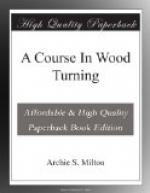In some details of chuck turning the tool operations already learned can be employed, but for the most part they are entirely different. In order to preserve the educational value of the work as brought out by skill and dexterity in handling tools, it will be necessary to use the cutting method wherever possible. In some instances that method will be impossible, and the scraping method must be used.
METHODS OF FASTENING STOCK
All the work thus far has been on models where the stock worked upon is held between the live and dead centers. In face-plate and chuck turning the work is done at the head stock only and the piece is supported by means of a face-plate, or chuck, that is fastened to a face-plate, which is screwed onto the end of the live spindle. There are three methods of fastening stock to the face-plate, and it depends upon the nature of the exercise or model to be made which method is used.
1. Small single screw face-plate. For all work that does not require deep cutting in the center, such as in towel rings, picture frames, etc., the small face-plate with a single screw should be used.
Note:—Should it be found difficult to keep the block from working loose and turning, it is a good plan to fold a piece of sandpaper, grit side out, and place it between the face-plate and the stock.
2. Large surface screw face-plate. For all work that does not require deep cutting on the outside, such as exercises, jewel boxes, etc., as well as all large stock, and all stock from which chucks are to be made, the large face-plate with the surface screws should be used.
3. Gluing to waste stock. A block of scrap wood is fastened to a face-plate the same as for a chuck and surfaced off square. The block from which the model is to be made is planed square on one side and glued to the block on the face-plate with a sheet of paper between the two. To separate the model from the chuck, after it is completed, place a chisel on the waste stock, 1/16” back of the glue joint at such a point as will bring the chisel parallel to the grain of the model, and strike lightly with a mallet. This will cause the paper to separate and the model to become free.
This method will be found very convenient epecially on models where the base is to be left straight. It will also be found to save much stock when working with expensive woods.
LATHE ADJUSTMENTS
To get the best results in face-plate or chuck turning there should be no end play in the spindle of the lathe. The spindle should always be tested out, and if any play is found, should be adjusted before attempting any work. It is almost impossible to make a true cut when such a condition obtains.




